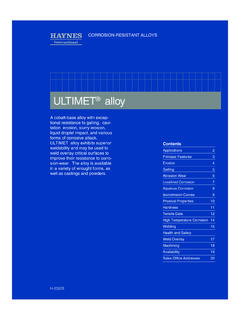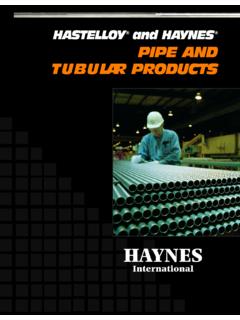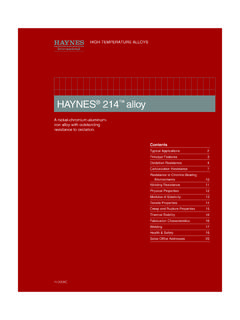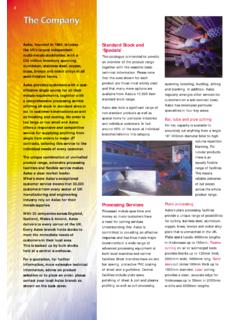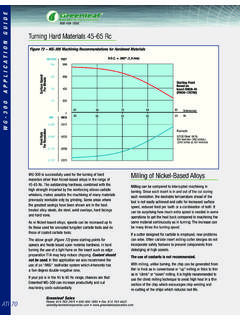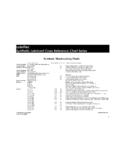Transcription of FABRICATION OF HASTELLOY CORROSION …
1 1 General Guidelines forWelding, Brazing, Hot andCold Working, Heat Treating,Pickling and FinishingH-2010 FFABRICATION OF HASTELLOY CORROSION -RESISTANT ALLOYSCORROSION-RESISTANT ALLOYSC ontentsIntroduction2 Welding3 Safety and HealthConsiderations15 Brazing16 Lining18 Hot Working25 Cold Working27 Heat Treatment30 Descaling and Pickling32 Grinding and Machining34 Appendix - SelectedData and Information37 Chemical Compositions37 Available Forms38 Wire and Electrode Sizes38 ASME and AWSS pecifications38 Comparative Properties38 Thermal Expansion39 Thermal Conductivity39 Sales
2 Offices Addresses40 2003, Haynes International, brochure is a general guide tothe FABRICATION of the CORROSION -resistant alloys produced by HaynesInternational, Inc. It is not to beconsidered as a detailedinstruction following CORROSION -resistantalloys covered in detail in this guideinclude: HASTELLOY B-2 alloyHASTELLOY B-3 alloyHASTELLOY C-4 alloyHASTELLOY C-22 alloyHASTELLOY C-2000 alloyHASTELLOY C-276 alloyHASTELLOY G-30 alloyHASTELLOY N alloyHASTELLOY B-2 alloy is a nickel-based wrought alloy with excellentresistance to hydrochloric acid at allconcentrations and temperatures.
3 Italso withstands hydrogen chloride,sulfuric, hydrofluoric, acetic, andreagent grade phosphoric alloy has excellent resistance tostress CORROSION cracking and toknife-line and heat-affected zoneattack. It resists the formation ofgrain-boundary carbide precipitatesin the weld heat-affected zone, thusmaking it suitable for use in specificchemical process applications in theas-welded for Bulletin H-2006 HASTELLOY B-3 alloy is anadditional member of the nickel-molybdenum family of alloys withexcellent resistance to hydrochloricacid at all concentrations andtemperatures.
4 It also withstandssulfuric, acetic, formic andphosphoric acids, and othernonoxidizing media. B-3 alloy has aspecial chemistry designed toachieve a level of thermal stabilitygreatly superior to that of itspredecessors, HASTELLOYB-2 alloy. B-3 alloy has excellentresistance to pitting CORROSION , tostress- CORROSION cracking, and toknife-line and heat-affected for Bulletin H-2104 HASTELLOY C-4 alloy is a nickel-chromium-molybdenum alloy withoutstanding high-temperaturestability, as evidenced by highductility and CORROSION resistanceeven after longtime aging at 1200 to1900 F (649 to 1038 C).
5 The alloyalso has excellent resistance tostress CORROSION cracking and tooxidizing atmospheres up to 1900 F(1038 C).Ask for Bulletin H-2007 HASTELLOY C-22 alloy aversatile nickel-chromium-molybdenum-tungsten alloy withbetter overall CORROSION resistancethan other Ni-Cr-Mo-W alloysavailable today, includingHASTELLOY C-276 and C-4 alloysand HAYNES 625 alloy. C-22 alloyhas outstanding resistance to pitting,crevice CORROSION , and stresscorrosion cracking. By virtue of itshigher chromium content, C-22 alloyis more resistant than C-4 andC-276 alloys to oxidizing acids andto acid streams containing oxidizingresiduals such as dissolved oxygen,ferric ions, and wet chlorine.
6 In fact,it is second only to C-2000 alloy inits versatility. Because of suchversatility it can be used in multi-purpose processes and where"upset" conditions are likely to for Bulletin H-2019 HASTELLOY C-2000 alloy wasdesigned to resist an extensiverange of corrosive chemicals,including sulfuric, hydrochloric, andhydrofluoric acids. Unlike previousNi-Cr-Mo alloys , which wereoptimized for use in either oxidizingor reducing acids, C-2000 alloyextends CORROSION resistance in bothtypes of environments. Thecombination of molybdenum andcopper provide the outstandingresistance to reducing media, whileoxidizing acid resistance is providedby a high chromium content.
7 C-2000alloy also exhibits pitting resistanceand crevice CORROSION resistancesuperior to the industry standard,C-276 alloy. Its forming, welding,and machining characteristics aresimilar to C-276 for Bulletin H-2111 HASTELLOY C-276 alloy hasexcellent resistance to pitting, stresscorrosion cracking, and acidenvironments. It has exceptionalresistance to a wide variety ofchemical process environments,including strong oxidizers such asferric and cupric chlorides, hotcontaminated media (organic andinorganic), chlorine, formic andacetic acids, acetic anhydride, andseawater and brine for Bulletin H-2002 HASTELLOY G-30 alloy is a highchromium nickel-based alloy whichshows superior CORROSION resistanceover most other nickel- and iron-based alloys in commercialphosphoric acids as well as manycomplex environments containinghighly oxidizing acids such as nitric/hydrochloric, nitric/hydrofluoric, andsulfuric acids.
8 The resistance ofG-30 alloy to the formation of grainboundary precipitates in the heat-affected zone makes it suitable foruse in the as-welded for Bulletin H-2028 HASTELLOY N alloy is a nickel-based alloy that was developed as acontainer material for molten fluoridesalts. It has good oxidationresistance to hot fluoride salts in thetemperature range of 1300 to1600 F (704 to 871 C). Alloy N ismost useful in environmentsinvolving fluorides at hightemperatures; however, the alloycompares favorably with otherHASTELLOY alloys in various othercorrosive media.
9 It is especiallysuggested that the alloy be tested inmolten halides of zirconium,beryllium, lithium, sodium,potassium, thorium, or for Bulletin H-2052 The nominal chemical compositionsof these alloys and the availableproduct forms can be found inTables A-1 and A-2, respectively, inthe Appendix. 2003 by Haynes International, WeldingThe welding characteristics of theHASTELLOY CORROSION -resistantalloys are similar in many ways tothose of the austenitic stainlesssteels and present no specialwelding problems, if propertechniques and procedures a way of achieving qualityproduction welds, developmentand qualification of weldingprocedure specifications issuggested.
10 Such procedures areusually required for codefabrication, and should take intoaccount parameters such as, butnot limited to, base and fillermaterials, welding process, jointdesign, electrical characteristics,preheat/interpass control, andpostweld heat modern welding power supplywith adequate output and controlsmay be used with the commonfusion welding , welding heat input iscontrolled in the low to moderaterange. Wide weave beads are notrecommended. Stringer beadwelding techniques, with someelectrode/torch manipulation, general, nickel-based alloys willexhibit both sluggish welding andshallow penetration , care must be used withrespect to joint design and weldbead placement to insure thatsound welds with proper weldbead tie-in are achieved.





